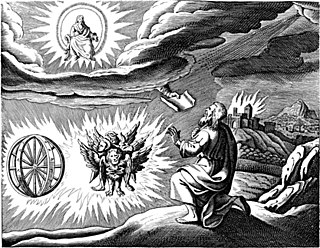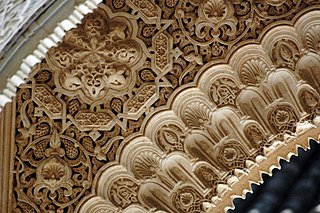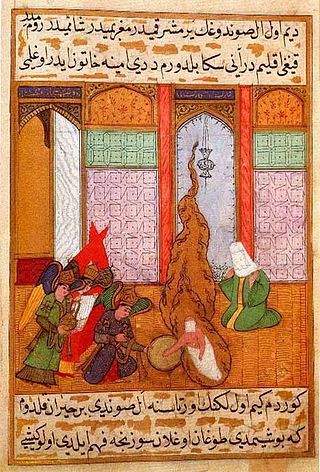
Angels have appeared in works of art since early Christian art, and they have been a popular subject for Byzantine and European paintings and sculpture.

Islamic art is a part of Islamic culture and encompasses the visual arts produced since the 7th century CE by people who lived within territories inhabited or ruled by Muslim populations. Referring to characteristic traditions across a wide range of lands, periods, and genres, Islamic art is a concept used first by Western art historians in the late 19th century. Public Islamic art is traditionally non-representational, except for the widespread use of plant forms, usually in varieties of the spiralling arabesque. These are often combined with Islamic calligraphy, geometric patterns in styles that are typically found in a wide variety of media, from small objects in ceramic or metalwork to large decorative schemes in tiling on the outside and inside of large buildings, including mosques. Other forms of Islamic art include Islamic miniature painting, artefacts like Islamic glass or pottery, and textile arts, such as carpets and embroidery.

Islamic culture or Muslim culture refers to the historic cultural practices that developed among the various peoples living in the Muslim world. These practices, while not always religious in nature, are generally influenced by aspects of Islam, particularly due to the religion serving as an effective conduit for the inter-mingling of people from different ethnic/national backgrounds in a way that enabled their cultures to come together on the basis of a common Muslim identity. The earliest forms of Muslim culture, from the Rashidun Caliphate to the Umayyad Caliphate and the early Abbasid Caliphate, was predominantly based on the existing cultural practices of the Arabs, the Byzantines, and the Persians. However, as the Islamic empires expanded rapidly, Muslim culture was further influenced and assimilated much from the Iranic, Pakistani, Caucasian, Turkic, Indian, Malay, Somali, Berber, and Indonesian cultures.
Aniconism is the cultural absence of artistic representations (icons) of the natural and supernatural worlds, or it is the absence of representations of certain figures in religions. The prohibition of material representations may only extend to a specific supreme deity, or it can encompass an entire pantheon, it can also include depictions of a prophet, saints, or sages, or even depictions of living beings and anything in existence generally. It is generally codified by religious traditions and as such, it becomes a taboo. When it is enforced by the physical destruction of images, aniconism becomes iconoclasm.

Siyer-i Nebi is an Ottoman epic on the life of the Islamic prophet Muhammad, completed around 1388, written by Mustafa, a Mevlevi dervish on the commission of Sultan Barquq, the Mamluk ruler in Cairo. The text is based on the 13th-century writings of Abu’l Hasan al-Bakri and Ibn Hisham. This epic would later be illustrated by Mustafa ibn Vali in the late 16th century, as commissioned by his patron, Sultan Murad III.
The Jyllands-Posten Muhammad cartoons were first published by Jyllands-Posten in late September 2005; approximately two weeks later, nearly 3,500 people demonstrated peacefully in Copenhagen. In November, several European newspapers re-published the images, triggering more protests.

Danish newspaper Jyllands-Posten's publication of satirical cartoons of the Islamic prophet Muhammad on September 30, 2005, led to violence, arrests, inter-governmental tension, and debate about the scope of free speech and the place of Muslims in the West. Many Muslims stressed that the image of Muhammad is blasphemous, while many Westerners defended the right of free speech. A number of governments, organizations, and individuals have issued statements defining their stance on the protests or cartoons.
This page collects opinions, other than those of governments or inter-governmental organizations, on the Jyllands-Posten Muhammad cartoons controversy. For an overview, and details on the controversy please see the main page.

In some forms of Islamic art, aniconism stems in part from the prohibition of idolatry and in part from the belief that the creation of living forms is God's prerogative.

In Islam, Muḥammad is venerated as the Seal of the Prophets and earthly manifestation of primordial divine light (Nūr), who transmitted the eternal word of God (Qur'ān) from the angel Gabriel (Jabrāʾīl) to humans and jinn. Muslims believe that the Quran, the central religious text of Islam, was revealed to Muhammad by God, and that Muhammad was sent to guide people to Islam, which is believed not to be a separate religion, but the unaltered original faith of mankind (fiṭrah), and believed to have been shared by previous prophets including Adam, Abraham, Moses, and Jesus. The religious, social, and political tenets that Muhammad established with the Quran became the foundation of Islam and the Muslim world.

The holiest sites in Islam are located in the Arabian Peninsula. While the significance of most places typically varies depending on the Islamic sect, there is a consensus across all mainstream branches of the religion that affirms two cities as having the highest degree of holiness, in descending order: Mecca, and Medina. Mecca's Al-Masjid al-Haram, Al-Masjid an-Nabawi in Medina are all revered by Muslims as sites of great importance.

The Jyllands-Posten Muhammad cartoons controversy began after the Danish newspaper Jyllands-Posten published 12 editorial cartoons on 30 September 2005, most of which depicted Muhammad, a principal figure of the religion of Islam. The newspaper announced that this was an attempt to contribute to the debate about criticism of Islam and self-censorship. Muslim groups in Denmark complained, and the issue eventually led to protests around the world, including violence and riots in some Muslim countries.

The Turkish and Islamic Arts Museum is a museum located in Sultanahmet Square in Fatih district of Istanbul, Turkey. Constructed in 1524, the building was formerly the palace of Pargalı Ibrahim Pasha, who was the second grand vizier to Suleiman the Magnificent, and was once thought to have been the husband of the Sultan's sister, Hatice Sultan.

In Islam, blasphemy is impious utterance or action concerning God, but is broader than in normal English usage, including not only the mocking or vilifying of attributes of Islam but denying any of the fundamental beliefs of the religion. Examples include denying that the Quran was divinely revealed, the Prophethood of one of the Islamic prophets, insulting an angel, or maintaining God had a son.

The Lars Vilks Muhammad drawings controversy began in July 2007 with a series of drawings by Swedish artist Lars Vilks that depicted the Islamic prophet Muhammad as a roundabout dog. Several art galleries in Sweden declined to show the drawings, citing security concerns and fear of violence. The controversy gained international attention after the Örebro-based regional newspaper Nerikes Allehanda published one of the drawings on 18 August as part of an editorial on self-censorship and freedom of religion.
Nakkaş Osman was the chief miniaturist for the Ottoman Empire during the later half of the sixteenth century. The dates of his birth and death are poorly known, but most of his works are dated to the last quarter of the sixteenth century.

The Cartoons that Shook the World is a 2009 book by Brandeis University professor Jytte Klausen about the Jyllands-Posten Muhammad cartoons controversy. Klausen contends that the controversy was deliberately stoked up by people with vested interests on all sides, and argues against the view that it was based on a cultural misunderstanding about the depiction of Muhammad. The book itself caused controversy before its publication when Yale University Press removed all images from the book, including the controversial cartoons themselves and some other images of Muhammad.

The term ḥilya denotes both a visual form in Ottoman art and a religious genre of Ottoman-Arabic literature each dealing with the physical description of Muhammad. Hilya means "ornament". They originate with the discipline of shama'il, the study of Muhammad's appearance and character, based on hadith accounts, most notably al-Tirmidhi's Shama'il al-Muhammadiyya "The Sublime Characteristics of Muhammad". In Ottoman-era folk Islam, there was a belief that reading and possessing Muhammad's description protects the person from trouble in this world and the next, it became customary to carry such descriptions, rendered in fine calligraphy and illuminated, as amulets. In 17th-century Ottoman Turkey, ḥilān developed into an art form with a standard layout, often framed and used as a wall decoration. Later ḥilān were written for the four Rashid caliphs, the Companions of the Prophet, Muhammad's grandchildren Hasan and Husayn, and walis or saints.

Islamic teachings and argument have been used to censor opinions and writings throughout history, up to and including the modern era, and thus there are many cases of censorship in Islamic societies. One example is the fatwa against The Satanic Verses, ordering that the author be executed for blasphemy. Depictions of Muhammad have inspired considerable controversy and censorship. Some Islamic societies have religious police, who enforce the application of Islamic Sharia law.

The Khalili Collection of Hajj and the Arts of Pilgrimage is a private collection of around 5,000 items relating to the Hajj, the pilgrimage to the holy city of Mecca which is a religious duty in Islam. It is one of eight collections assembled, conserved, published and exhibited by the British scholar, collector and philanthropist Nasser Khalili; each collection is considered among the most important in its field. The collection's 300 textiles include embroidered curtains from the Kaaba, the Station of Abraham, the Mosque of the Prophet Muhammad and other holy sites, as well as textiles that would have formed part of pilgrimage caravans from Egypt or Syria. It also has illuminated manuscripts depicting the practice and folklore of the Hajj as well as photographs, art pieces, and commemorative objects relating to the Hajj and the holy sites of Mecca and Medina.
















































































